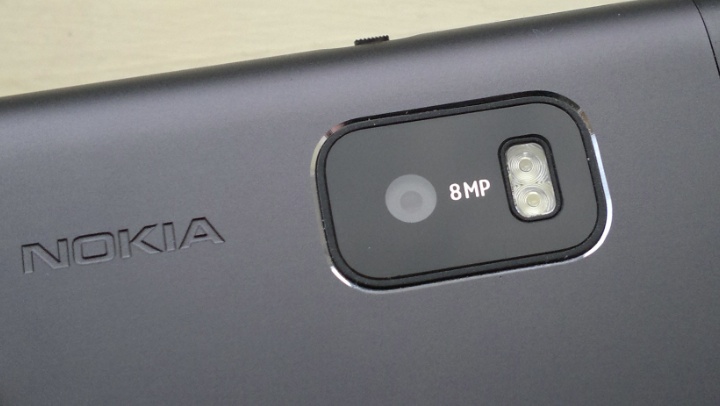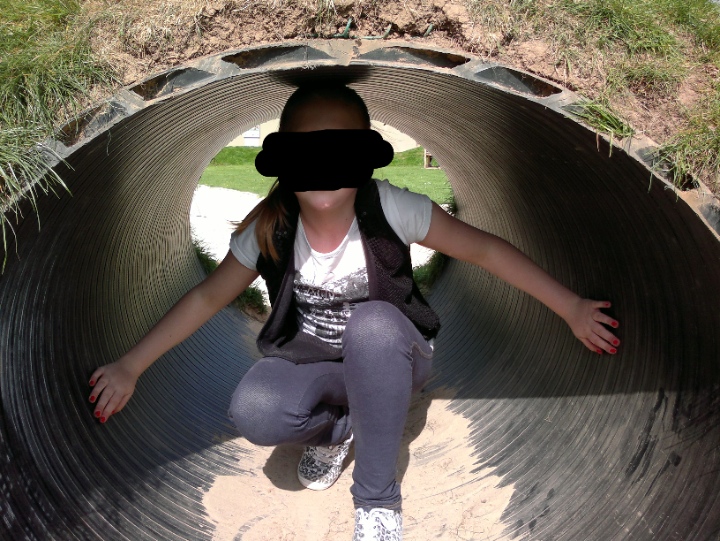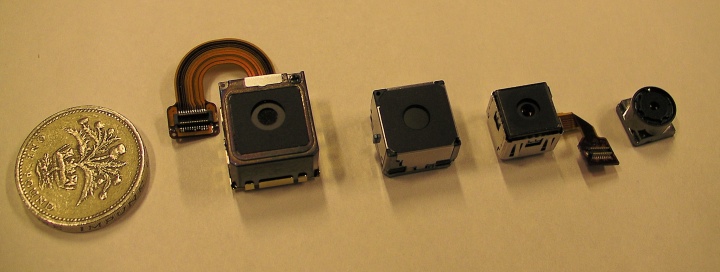Stunning EDoF examples
Before going any further, it's worth posting a couple of good examples of what an EDoF camera in a Nokia phone can do, both from this weekend on my Nokia E7. Click on the image to download or enlarge to full 8 megapixel resolution:
Not bad, eh? But you might argue that everything's a fair way from the phone in the shot above, so EDoF had an easy time of it. Let's try something more challenging, in this case my daughter in a little tunnel down at the park. Again, click on the image to download or enlarge to full 8 megapixel resolution:
To be honest, for an everyday photo, this is really impressive. Everything, from the top of foreground tunnel entrance to (most importantly) the subject, is crisp and clear.
If the above two photos represent your own typical subjects then, if anything, you'll get better results from EDoF than you would with an auto-focus unit in your phone.
But let's take a step back. What is EDoF and what exactly can it do? And what can't it do?
The pros and cons of EDoF
The first Nokia smartphones to have EDoF (Extended Depth of Field, see the box-out below) were the E52 and E55, reviewed here. Since then, we've had a variety of S60 3rd Edition and Symbian^3 phones with EDoF, including the E5 - and C6-01, C7, and E7, most recently. And now two new phones, the X7 and E6 have been announced, both also with EDoF. So what are Nokia thinking?
The thing about auto-focus cameras is that, to keep the quality up to Nokia's 'standards' (i.e. pretty decent), the higher you take the megapixel count, the larger the lens and moving optics have to be, the larger the sensor and the greater the physical depth of the unit. Many other manufacturers get round the size problem by making the camera smaller anyway and accepting the fact that the 5 or 8 megapixel images will be of lower quality (this is often disguised with zealous sharpening of each photo in software, to disguise the lack of genuine resolution).
But, as I say, I believe Nokia wanted to keep the quality of images as high as possible and yet still crank out device designs which were thin enough to impress in the 2010/2011 market. Which is where EDoF comes in. From my earlier article, here are the camera modules of the Nokia N73, N86, N97 - and the EDoF-equipped C7, on the far right (the same unit that's in the E7 and, presumably, in the X7 and E6):
By eliminating mechanical, moving optics, these EDoF cameras can be significantly thinner than auto-focus units. Meaning the difference between a smartphone that's 13mm thick and one that's 10mm at its thickest part.
In addition, EDoF cameras:
- (despite the high technology that goes into making them) probably work out cheaper to manufacture (after the original R&D)
- are more robust
- don't need expensive two-stage shutter buttons
- produce better video output
- have no 'shutter lag' or auto-focus delay - shot to shot times can be less than a second, making EDoF great for 'action' environments
- assume no photographic expertise on the part of the phone user - photos can be snapped instantly without worrying about subject movement or focus
So quite a litany of positives, then, aside from the reduction in camera unit size. On the downside, the big one is that because of the way EDoF works (see boxout below), there's no way to get crisp images of anything closer than about 40cm, i.e. no macro photography. Plus, because the overall camera unit is smaller, the sensor will be smaller (as with competing non-Nokia auto-focus units), so there may well be issues with gathering enough light when conditions aren't ideal.
EDoF stands for Extended Depth of Field and works by using an asymmetrical lens that has the capability to focus objects from different distances, depending on which parts of the lens the various light 'rays' strike, on the same sensor. Internally, this naturally results in an unholy blurred mess, but by using chromatic tricks (using the different optical characteristics of different colour frequencies), by knowing the exact optical properties of the asymmetries in the lens and by using a healthy dose of very clever enhancement electronics, the mess is largely cleared up to produce images that, to the naked eye are pretty clear, whatever the subject, in good light.
Should I buy a smartphone with an EDoF camera?
With the fairly large number of pros and cons just mentioned, it's perhaps not surprising that many people are still confused by EDoF and I consistently get the question (about once a day): "Should I get device XX (- with EDoF)? - Will I regret it?"
It all depends on what sort of subjects you like shooting with your phone. It's a fair bet that you're not a semi-pro photographer like me or James Burland - you're not going to be publishing your images anywhere critical. (For absolute quality, you'd want auto-focus, time to set up a shot and talent to get everything right.) But your phone is the camera that's always with you and there will be some shots you want to snap.
Here's my subject guide, noting where EDoF and auto-focus cameras have the edge:
| Subject, in good light | EDoF camera (e.g. on Nokia E7, C7, E6) | Auto-focus camera (e.g. on Nokia E72, X6, N8) |
| Posed friend or family member at 1 metre (head and shoulders/chest) | Good. | Excellent. |
| Posed group of 3 friends, standing shoulder to shoulder | Excellent | Excellent. |
| General scene, with multiple people at various distances, animals, no posing, e.g. at a big (well lit) social event | Excellent, everything should be in focus and shutter time will be small. | OK, some subjects close to you and far away may be a little out of focus. With people moving, you'll struggle to focus accurately much of the time. |
| Static pet, flowers or favourite object, 30cm (one ruler length) distance | Blurred, out of focus, too close for EDoF. Annoyingly, the background will be in 'focus', making the contrast rather obvious. As with document capture, mentioned below, it's easy enough to take the shot at 60cm instead though, and accept having to crop it down on the phone or desktop later. Not a showstopper. | Excellent, perfect for auto-focus use. |
| Landscape, view out of hotel window, beach scene, sunset, etc. | Excellent. | Good to excellent, depending on what, if any, subject material is in the medium foreground. |
| Car, perhaps your own that you're about to sell or one that you like and want to remember | Excellent. | Good-ish, depending on the angle and range you shoot from - it's easy to get part of the car in focus and a different part, closer or further away, out of focus. |
| Whiteboard with plans or diagrams, perhaps after a meeting | Good, you'll be shooting from about a metre, typically, and the result will be easily readable | Excellent, image will be perfect |
| A4 document/page that you've been given (legal) access to | Taken at around 15cm, you'll get an acceptable fascimile for casual use. See my article on testing document capture on the EDoF-equipped E7 here. Pretty useless as a photocopier or for optical character recognition, but OK if you just want a visual memory jogger. | Excellent. |
| Business card, with a contact's details | If you're canny, you'll shoot at around 15 to 18 cm and then crop later, but again it's for your eyes and intelligence to read and not 'machine readable'. | Excellent. |
So nine possible use cases for your smartphone photos, of which only the last two present any kind of problem. And, notably, in three of the use cases the EDoF-equipped phone will produce better results than an auto-focus equipped device.
All of which belies the roasting that Nokia's new devices have been getting in online reviews, again emphasising that the very people who write the reviews are the geeks, the power users, the top few percent of phone users in terms of technical awareness, who love snapping macro photos (of phones, accessories, meals, signs and so on). Nokia are betting that most (normal) people will fit into the first 6 or 7 use cases above and therefore will get as good, or maybe better results with EDoF than auto-focus. Certainly real beginners will shoot better photos, since there's less to understand and therefore less to mess up.
I'd therefore argue that Nokia has made a good call for the mass market in promoting EDoF and enjoying the thinner form factors that become possible, though I personally would like a few auto-focus designs to remain, if only to give users more of a choice.

The big caveat in all the above is light, a factor which doesn't get anywhere near enough recognition. Lack of light is why many phone-taken photos come out poorly and why phone cameras generally have a bad reputation. But it's just a matter of physics. Photons of light hit the sensor micro-sites/pixels in a camera sensor and trigger electrons that get captured and turned into data by the electronics - if there are less photons then there will be less certainty over what each pixel should be set to and, as the light continues to drop, pixels start going 'random' and digital noise creeps into photos. This applies to any camera, standalone or in a camera phone, and it's utterly dependent on lens aperture and on the size of the sensor.
We've established that EDoF cameras tend to be smaller in all dimensions than auto-focus ones - it's their biggest advantage to a manufacturer designing a new phone. But it also means that EDoF cameras tend to get affected more adversely than Nokia's auto-focus cameras, which tend to have bigger lenses and bigger sensors (e.g. Nokia N97/N96/N8). In practice this means that in all the use cases above, EDoF will deteriorate quicker as the light levels drop. It's not a showstopping problem, but it is something to be aware of.
Having a dual LED flash on hand helps to a degree, but you'll still end up with greater levels of noise and anything moving will end up blurred since the 'shutter speed' is automatically lengthened to allow more photons into the camera hardware.
Specific use case examples
You'll have seen numerous EDoF examples in our various device reviews, of course. And you'll have seen the train example at the top of this piece, but I've still got a number of example images which are relevant here.
Here's your typical 'kids at the park action shot', taken in overcast, i.e. not perfect conditions. Yet EDoF is still fast enough to capture the girl in mid-air with no blurring. This is easily, overwhelmingly good enough for most people. And in fact you wouldn't get close to this with autofocus, since you'd have to really cunning on prefocussing to snap it at all.
Again, click on the image to download or enlarge to full 8 megapixel resolution:
EDoF comes off worst in the 'macro' use case mentioned above, listed as for a "pet, flower or favourite object". So let's take the suggestion above and shoot some pretty flowers (all of these examples are on the Nokia E7, by the way) at about 60cm, to bring them into EDoF range, and then simply crop away the outer 50% of the photo:

Photo purists wouldn't like having to throw away information and in this case would point out that the lesser EDoF lens and sensor couldn't cope with the sunlight - see the overblown white highlights - but I'd argue that for casual use, the photo above will be quite sufficient to remind someone of a favourite moment or thing.
I've mentioned several times that all of this really only applies in reasonable light - if the light levels get too low then the small EDoF lenses and sensors (not to mention the EDoF electronics) all struggle. Though, in fairness to EDoF, most other phone cameras struggle too. To test things, I handed the E7 to a complete technophobe (I had to explain where the shutter key was) and asked him to try to photograph me. Here's the resulting snap, on his first and only attempt:

It's not pin sharp, but then this was indoors 'pub' lighting, the phone had LED flash and not Xenon (as on the N8), and I can't think many other phone cameras would do much better. I'd rate this snap as 'as good as could be expected from LED-lit shot indoors on a phone' and, crucially, the fact that the camera unit was EDoF hasn't harmed the shot at all. In fact, in indoor lighting, I'd argue that auto-focus units might struggle to pick up focus, they'd take a while to do so and there would be far less chance of capturing 'the moment'.
Video is a big win
As mentioned above, the EDoF optics and chip in the most recent Nokia phones work in just the same way in video mode, which is something of a revelation, since it dramatically solves the perennial problem for video capture, which normally sees manufacturers (and phone fans) veering between fixed focus, initial focus and continuous auto-focus (or even no focus at all), all of which have distinct problems and issues. The Nokia N8, for example, has a pre-set, 'hyperfocal' focus set to a couple of metres or so and a resulting large depth of field, from about 60cm to infinity. (The 'Initial focus' scheme struggles when you change subject during the shot, while the 'Continuous focus' scheme usually suffers from distracting 'hunting' for focus as the subject matter keeps changing.)
In contrast, a video camera with EDoF results in genuinely crystal clear video from about 40cm to infinity - ok, it's a little 'processed' and thus artificial, but it's clearer to the naked eye than that on the Nokia N8, for example, though the latter's Carl Zeiss lens and larger sensor will help more as the light levels go down, just as it would for still photos.
As an example of quality, have another look at my short sequence of comparison video between the EDoF-equipped Nokia E7 and the camera-specialist N8 (and remember to select the highest resolution after you start playing and then make it full-screen):
Overall, video on EDoF cameras is impressive and is easily good enough, at 720p resolution, for most people's videos. In fact, picture-wise, it's just about the best there is, as in decent light EDoF video will trump every other video-capturing smartphone (including the N8!) for 90% of users - and it's trivially easy to use. Just press the shutter button and you're shooting and everything will be 'in focus' all the time.
EDoF the future?
Although Nokia's recent sequence of EDoF-equipped announcements has caught many people off balance, I hope I've shown above where it's strong and why - and why it's a better choice for general purpose phone use than you have been led to believe.
I don't expect every Nokia smartphone from here on in to have an EDoF camera - auto-focus will remain in 10 to 20% of models, I'd expect. But there's certainly enough justification for the other 80 to 90% of devices to have a small, thin, robust and simple EDoF unit on-board.
Steve Litchfield, All About Symbian, 17th April 2011




